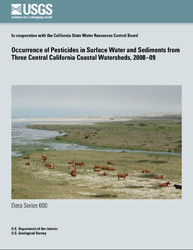 Abstract
Abstract
Water and sediment (bed and suspended) were collected from January 2008 through October 2009 from 12 sites in 3 of the largest watersheds along California’s Central Coast (Pajaro, Salinas, and Santa Maria Rivers) and analyzed for a suite of pesticides by the U.S. Geological Survey. Water samples were collected in each watershed from the estuaries and major tributaries during 4 storm events and 11 dry season sampling events in 2008 and 2009. Bed sediments were collected from depositional zones at the tributary sampling sites three times over the course of the study. Suspended sediment samples were collected from the major tributaries during the four storm events and in the tributaries and estuaries during three dry season sampling events in 2009.
Water samples were analyzed for 68 pesticides using gas chromatography/mass spectrometry. A total of 38 pesticides were detected in 144 water samples, and 13 pesticides were detected in more than half the samples collected over the course of the study. Dissolved pesticide concentrations ranged from below their method detection limits to 36,000 nanograms per liter (boscalid). The most frequently detected pesticides in water from all the watersheds were azoxystrobin, boscalid, chlorpyrifos, DCPA, diazinon, oxyfluorfen, prometryn, and propyzamide, which were found in more than 80 percent of the samples. On average, detection frequencies and concentrations were higher in samples collected during winter storm events compared to the summer dry season. With the exception of the fungicide, myclobutanil, the Santa Maria estuary watershed exhibited higher pesticide detection frequencies than the Pajaro and Salinas watersheds.
Bed and suspended sediment samples were analyzed for 55 pesticides using accelerated solvent extraction, gel permeation chromatography for sulfur removal, and carbon/alumina stacked solid-phase extraction cartridges to remove interfering sediment matrices. In bed sediment samples, 17 pesticides were detected including pyrethroid and organophosphate (OP) insecticides, p,pʹ-DDT and its degradates, as well as several herbicides. The only pesticides detected more than half the time were p,pʹ-DDD, p,pʹ-DDE, and p,pʹ-DDT. Maximum pesticide concentrations ranged from less than their respective method detection limits to 234 micrograms per kilogram (p,pʹ-DDE). Four pyrethroids (bifenthrin, λ-cyhalothrin, permethrin, and τ-fluvalinate) were detected in bed sediment samples, though concentrations were relatively low (less than 10 microgram per kilogram). The greatest number of pesticides were detected in samples collected from Lower Orcutt Creek, the major tributary to the Santa Maria estuary. In suspended sediment samples, 19 pesticides were detected, and maximum concentrations ranged from less than the method detection limits to 549 micrograms per kilogram (chlorpyrifos). The most frequently detected pesticides were p,pʹ-DDE (49 percent), p,pʹ-DDT (38 percent), and chlorpyrifos (32 percent). During storm events, 19 pesticides were detected in suspended sediment samples compared to 10 detected during the dry season. Pesticide concentrations commonly were higher in suspended sediments during storm events than during the dry season, as well.